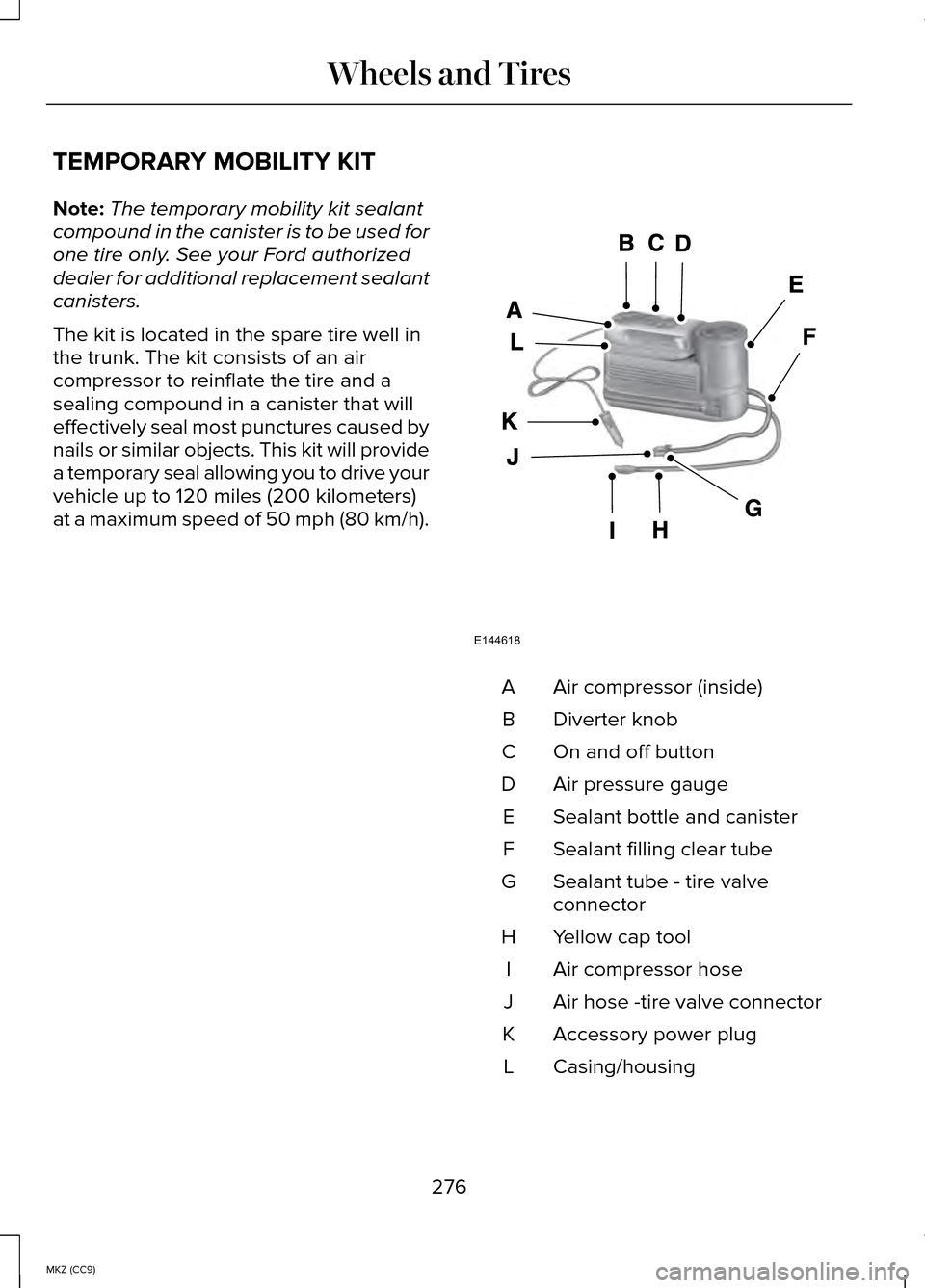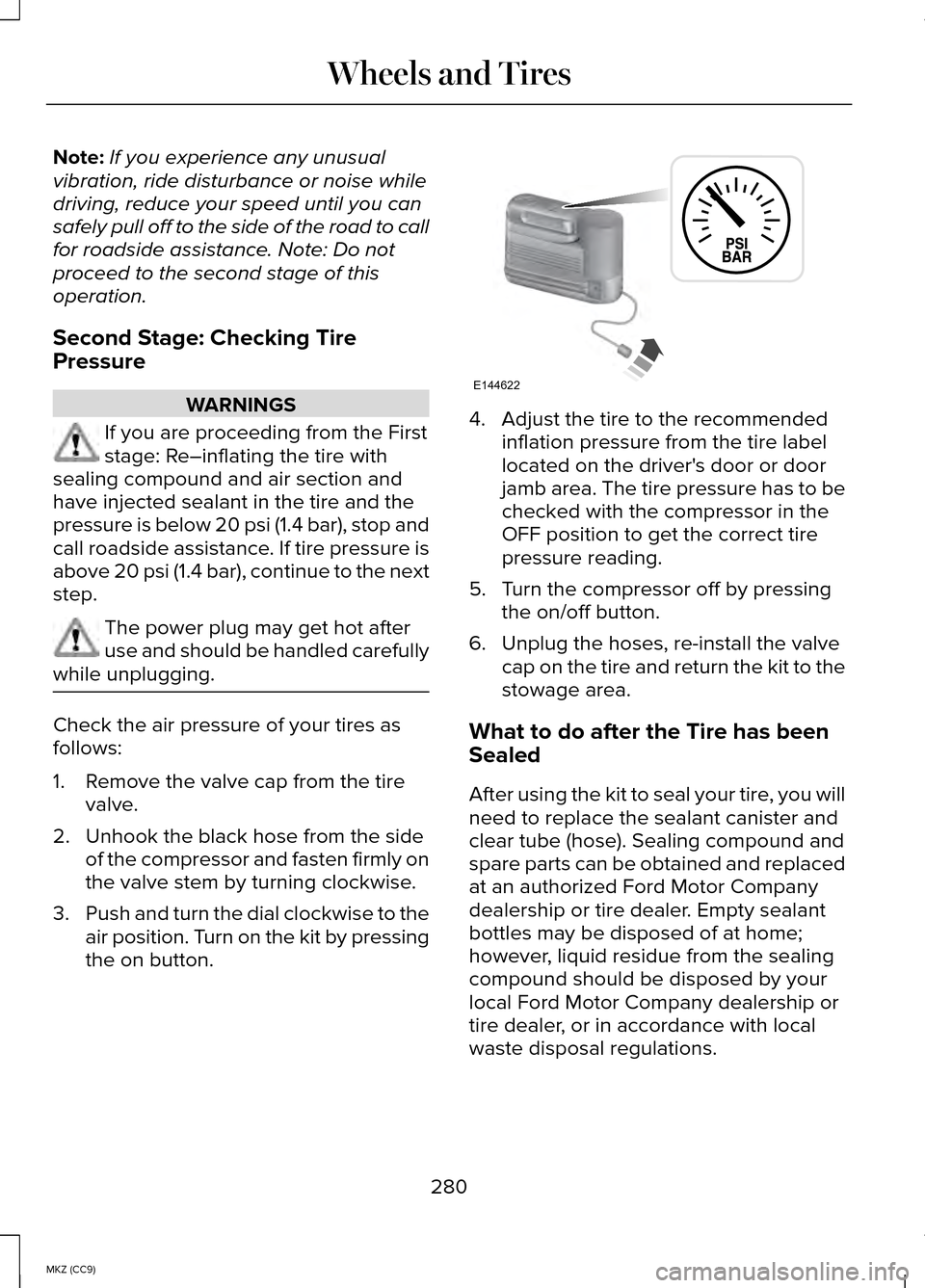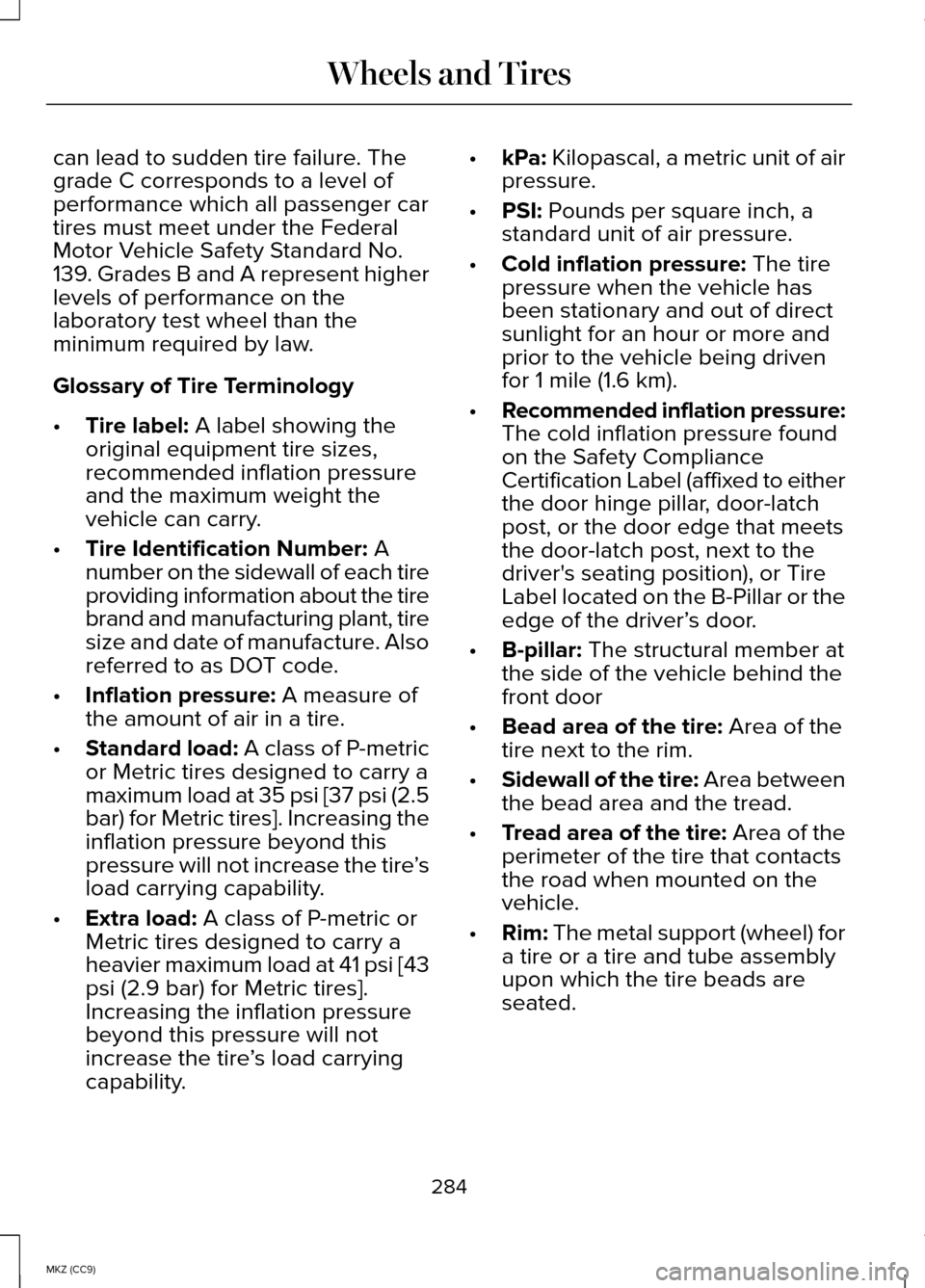2014 LINCOLN MKZ HYBRID tire pressure
[x] Cancel search: tire pressurePage 278 of 445

TEMPORARY MOBILITY KIT
Note:
The temporary mobility kit sealant
compound in the canister is to be used for
one tire only. See your Ford authorized
dealer for additional replacement sealant
canisters.
The kit is located in the spare tire well in
the trunk. The kit consists of an air
compressor to reinflate the tire and a
sealing compound in a canister that will
effectively seal most punctures caused by
nails or similar objects. This kit will provide
a temporary seal allowing you to drive your
vehicle up to 120 miles (200 kilometers)
at a maximum speed of 50 mph (80 km/h). Air compressor (inside)
A
Diverter knob
B
On and off button
C
Air pressure gauge
D
Sealant bottle and canister
E
Sealant filling clear tube
F
Sealant tube - tire valve
connector
G
Yellow cap tool
H
Air compressor hose
I
Air hose -tire valve connector
J
Accessory power plug
K
Casing/housing
L
276
MKZ (CC9) Wheels and TiresE144618
Page 279 of 445

General Information
WARNING
Failure to follow these guidelines
could result in an increased risk of
loss of vehicle control, injury or death. Note:
Do not use the kit if a tire has
become severely damaged by driving the
vehicle with a tire that has insufficient air
pressure. Only punctured areas located
within the tire tread can be sealed with
the kit.
Do not attempt to repair punctures larger
than 1/4 inch (6 millimeters) or damage to
the tire's sidewall. The tire may not
completely seal.
Loss of air pressure may adversely affect
tire performance. For this reason:
Note: Do not drive the vehicle above 50
mph (80 km/h).
Note: Do not drive further than 120 miles
(200 kilometers). Drive only to the closest
Ford Motor Company authorized dealer
or tire repair shop to have your tire
inspected.
• Drive carefully and avoid abrupt
steering maneuvers.
• Periodically monitor tire inflation
pressure in the affected tire; if the tire
is losing pressure, have the vehicle
towed.
• Read the information in the Tips for
Use of the Kit section to make sure
safe operation of the kit and your
vehicle. Tips for Use of the Kit
Read the following list of tips to ensure
safe operation of the kit:
•
Before operating the kit, make sure
your vehicle is safely off the road and
away from moving traffic. Turn on the
hazard lights.
• Always set the parking brake to ensure
the vehicle doesn't move
unexpectedly.
• Do not remove any foreign objects,
such as nails or screws, from the tire.
• When using the kit, leave the engine
running (only if the vehicle is outdoors
or in a well-ventilated area) so the
compressor doesn't drain the vehicle's
battery.
• Do not allow the compressor to
operate continuously for more than 15
minutes; this will help prevent the
compressor from overheating.
• Never leave the kit unattended when
it is operating.
• Sealant compound contains latex.
Make sure that you use the non-latex
gloves provided to avoid an allergic
reaction.
• Keep the kit away from children.
• Only use the kit when the ambient
temperature is between -22°F (–30°C)
and 158°F (70°C).
• Only use the sealing compound before
the use by date. The use by date is on
the lower right hand corner of the label
located on the sealant canister (bottle).
Check the use by date regularly and
replace the canister after four years.
277
MKZ (CC9) Wheels and Tires
Page 280 of 445

•
Do not store the kit unsecured inside
the passenger compartment of the
vehicle as it may cause injury during a
sudden stop or crash. Always store the
kit in its original location.
• After sealant use, the tire pressure
monitoring system sensor and valve
stem on the wheel must be replaced
by an authorized Ford dealer.
• When inflating a tire or other objects,
use the black air hose only. Do not use
the transparent hose which is designed
for sealant application only.
• Operating the kit could cause an
electrical disturbance in radio, CD, and
DVD player operation.
What to do when a Tire Is Punctured
A tire puncture within the tire's tread area
can be repaired in two stages with the kit.
• In the first stage, the tire will be
reinflated with a sealing compound
and air. After the tire has been
reinflated, you will need to drive the
vehicle a short distance (about 4 miles
[6 kilometers]) to distribute the sealant
in the tire.
• In the second stage, you will need to
check the tire pressure and adjust, if
necessary, to the vehicle's tire inflation
pressure. First Stage: Reinflating the Tire with
Sealing Compound and Air WARNINGS
Do not stand directly over the kit
while inflating the tire. If you notice
any unusual bulges or deformations in the
tire's sidewall during inflation, stop and call
roadside assistance. If the tire doesn't inflate to the
recommended tire pressure within
15 minutes, stop and call roadside
assistance. Preparation: Park the vehicle in a safe,
level and secure area, away from moving
traffic. Turn the hazard lights on. Apply the
parking brake and turn the engine off.
Inspect the flat tire for visible damage.
Sealant compound contains latex. To avoid
any allergic reactions, use the non-latex
gloves located in the accessory box on
the underside of the kit housing.
Do not remove any foreign object that has
pierced the tire. If a puncture is located in
the tire sidewall, stop and call roadside
assistance.
1. Remove the valve cap from the tire
valve.
2. Unwrap the clear tube from the compressor housing.
3. Remove the tube cap and fasten the metal connector of the tube to the tire
valve, turning clockwise. Make sure
the connection is tightly fastened.
278
MKZ (CC9) Wheels and Tires
Page 281 of 445

4. Plug the power cable into the 12-volt
power point in the vehicle.
5. Remove the warning sticker found on the canister and place it on the top of
the instrument panel or the center of
the dash.
6. Start the vehicle only if the vehicle is outdoors or in a well-ventilated area. 7.
Push and turn dial (A) counterclockwise
to the sealant position. Turn on the kit
by pressing the on/off button (B). 8.
Inflate the tire to the pressure listed on
the tire label located on the driver's
door or the door jamb area. When the
sealing compound is first added into
the tire, the air pressure gauge reading
on the compressor unit may indicate
a higher value; this is normal and
should be no reason for concern. The
pressure will drop after about 30
seconds of operation. The tire pressure
has to be checked with the
compressor in the OFF position to get
the correct tire pressure reading.
9. When the recommended tire pressure
is reached, turn off the kit by pressing
the on button; disconnect the kit from
the tire valve and the power point.
Re-install the valve cap on the tire
valve, place the tube cap on the metal
connector, and return the kit to the
stowage area
10. Immediately and cautiously, drive the
vehicle 4 miles (6 kilometers) to
distribute the sealant evenly inside
the tire. Do not exceed 50 mph (80
km/h).
11. After 4 miles (6 kilometers), stop and
check the tire pressure. See Second
stage: Checking tire pressure.
279
MKZ (CC9) Wheels and TiresE144619 E144924 E144621
Page 282 of 445

Note:
If you experience any unusual
vibration, ride disturbance or noise while
driving, reduce your speed until you can
safely pull off to the side of the road to call
for roadside assistance. Note: Do not
proceed to the second stage of this
operation.
Second Stage: Checking Tire
Pressure WARNINGS
If you are proceeding from the First
stage: Re–inflating the tire with
sealing compound and air section and
have injected sealant in the tire and the
pressure is below 20 psi (1.4 bar), stop and
call roadside assistance. If tire pressure is
above 20 psi (1.4 bar), continue to the next
step. The power plug may get hot after
use and should be handled carefully
while unplugging. Check the air pressure of your tires as
follows:
1. Remove the valve cap from the tire
valve.
2. Unhook the black hose from the side of the compressor and fasten firmly on
the valve stem by turning clockwise.
3. Push and turn the dial clockwise to the
air position. Turn on the kit by pressing
the on button. 4. Adjust the tire to the recommended
inflation pressure from the tire label
located on the driver's door or door
jamb area. The tire pressure has to be
checked with the compressor in the
OFF position to get the correct tire
pressure reading.
5. Turn the compressor off by pressing the on/off button.
6. Unplug the hoses, re-install the valve cap on the tire and return the kit to the
stowage area.
What to do after the Tire has been
Sealed
After using the kit to seal your tire, you will
need to replace the sealant canister and
clear tube (hose). Sealing compound and
spare parts can be obtained and replaced
at an authorized Ford Motor Company
dealership or tire dealer. Empty sealant
bottles may be disposed of at home;
however, liquid residue from the sealing
compound should be disposed by your
local Ford Motor Company dealership or
tire dealer, or in accordance with local
waste disposal regulations.
280
MKZ (CC9) Wheels and TiresE144622
Page 283 of 445

Note:
After the sealing compound has
been used, the maximum vehicle speed
is 50 mph (80 km/h) and the maximum
driving distance is 120 miles (200
kilometers). The sealed tire should be
inspected immediately.
Note: After sealant use, the tire pressure
monitoring system sensor and valve stem
on the wheel must be replaced by an
authorized Ford dealer.
You can check the tire pressure any time
within the 120 miles (200 kilometers) by
performing the procedure from Second
stage: Checking tire pressure listed
previously.
Removal of the sealant canister from the
kit 1. Unwrap the clear tube from the
compressor housing. 2.
Locate the yellow cap at the end of the
clear tube. 3. Using the yellow cap tool, press the
tab located on the kit compressor
housing while pulling up on the sealant
canister.
Installation of the sealant canister to the
kit 1. Align the sealant canister with the kit
housing.
281
MKZ (CC9) Wheels and TiresE144623 E144624 E144625 E144626
Page 286 of 445

can lead to sudden tire failure. The
grade C corresponds to a level of
performance which all passenger car
tires must meet under the Federal
Motor Vehicle Safety Standard No.
139. Grades B and A represent higher
levels of performance on the
laboratory test wheel than the
minimum required by law.
Glossary of Tire Terminology
•
Tire label: A label showing the
original equipment tire sizes,
recommended inflation pressure
and the maximum weight the
vehicle can carry.
• Tire Identification Number:
A
number on the sidewall of each tire
providing information about the tire
brand and manufacturing plant, tire
size and date of manufacture. Also
referred to as DOT code.
• Inflation pressure:
A measure of
the amount of air in a tire.
• Standard load:
A class of P-metric
or Metric tires designed to carry a
maximum load at 35 psi [37 psi (2.5
bar) for Metric tires]. Increasing the
inflation pressure beyond this
pressure will not increase the tire ’s
load carrying capability.
• Extra load:
A class of P-metric or
Metric tires designed to carry a
heavier maximum load at 41 psi [43
psi (2.9 bar) for Metric tires].
Increasing the inflation pressure
beyond this pressure will not
increase the tire ’s load carrying
capability. •
kPa:
Kilopascal, a metric unit of air
pressure.
• PSI:
Pounds per square inch, a
standard unit of air pressure.
• Cold inflation pressure:
The tire
pressure when the vehicle has
been stationary and out of direct
sunlight for an hour or more and
prior to the vehicle being driven
for 1 mile (1.6 km).
• Recommended inflation pressure:
The cold inflation pressure found
on the Safety Compliance
Certification Label (affixed to either
the door hinge pillar, door-latch
post, or the door edge that meets
the door-latch post, next to the
driver's seating position), or Tire
Label located on the B-Pillar or the
edge of the driver’ s door.
• B-pillar:
The structural member at
the side of the vehicle behind the
front door
• Bead area of the tire:
Area of the
tire next to the rim.
• Sidewall of the tire: Area between
the bead area and the tread.
• Tread area of the tire: Area of the
perimeter of the tire that contacts
the road when mounted on the
vehicle.
• Rim:
The metal support (wheel) for
a tire or a tire and tube assembly
upon which the tire beads are
seated.
284
MKZ (CC9) Wheels and Tires
Page 287 of 445

Information Contained on the Tire
Sidewall
Both U.S. and Canada Federal
regulations require tire manufacturers
to place standardized information on
the sidewall of all tires. This
information identifies and describes
the fundamental characteristics of the
tire and also provides a U.S. DOT Tire
Identification Number for safety
standard certification and in case of a
recall.
Information on P Type Tires
P215/65R15 95H is an example of a
tire size, load index and speed rating.
The definitions of these items are
listed below. (Note that the tire size,
load index and speed rating for your
vehicle may be different from this
example.) A. P: Indicates a tire, designated by
the Tire and Rim Association, that may
be used for service on cars, sport
utility vehicles, minivans and light
trucks. Note: If your tire size does not
begin with a letter this may mean it is
designated by either the European
Tire and Rim Technical Organization
or the Japan Tire Manufacturing
Association.
B.
215: Indicates the nominal width of
the tire in millimeters from sidewall
edge to sidewall edge. In general, the
larger the number, the wider the tire.
C. 65: Indicates the aspect ratio which
gives the tire's ratio of height to width.
D.
R: Indicates a radial type tire.
E.
15: Indicates the wheel or rim
diameter in inches. If you change your
wheel size, you will have to purchase
new tires to match the new wheel
diameter.
F.
95: Indicates the tire's load index.
It is an index that relates to how much
weight a tire can carry. You may find
this information in your owner’ s
manual. If not, contact a local tire
dealer.
Note: You may not find this
information on all tires because it is
not required by federal law.
G.
H: Indicates the tire's speed rating.
The speed rating denotes the speed
at which a tire is designed to be driven
for extended periods of time under a
standard condition of load and
inflation pressure. The tires on your
vehicle may operate at different
285
MKZ (CC9) Wheels and TiresH
I
J
KL
M
A
B
CDEFG
E142543